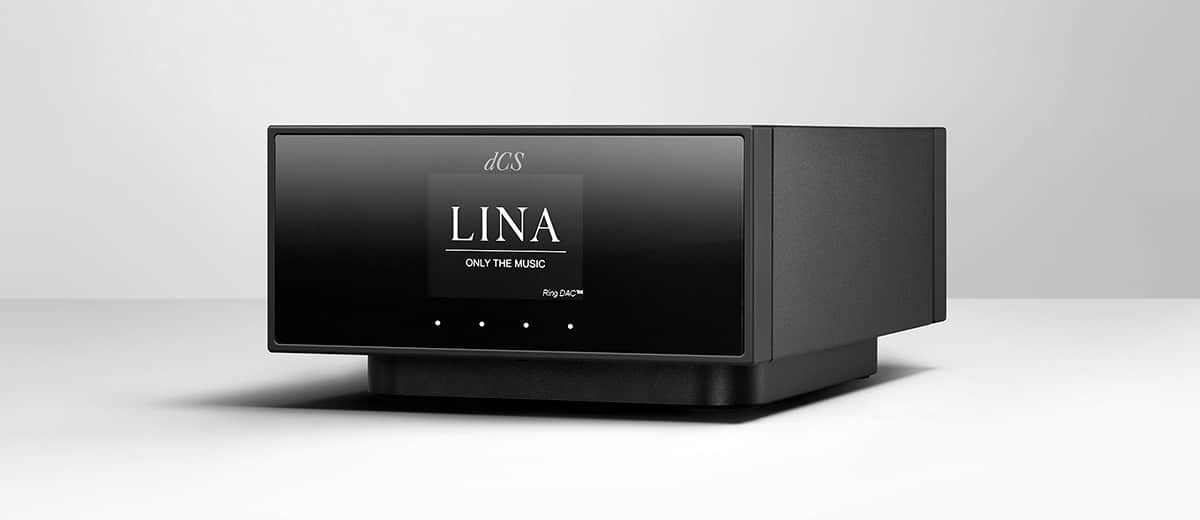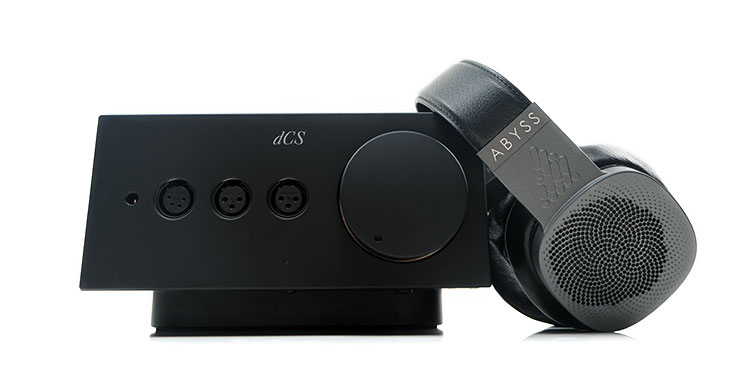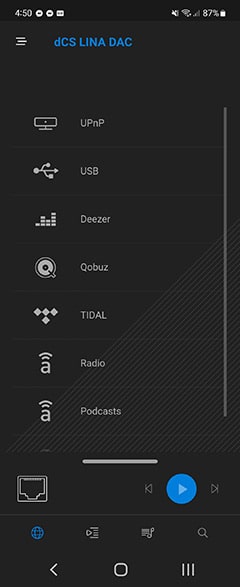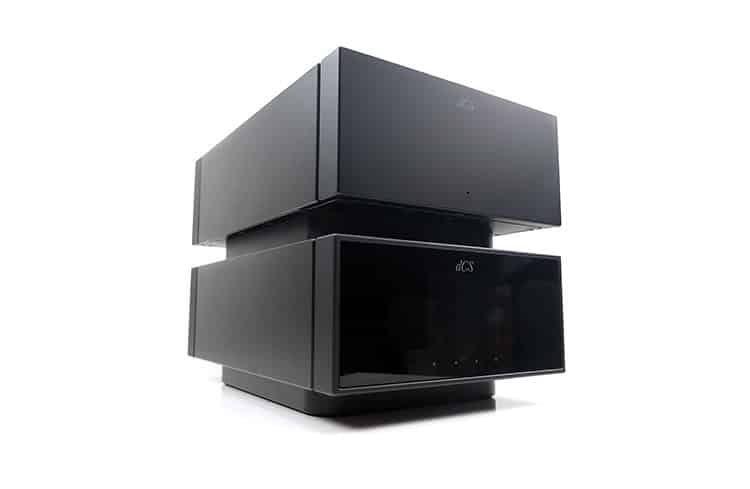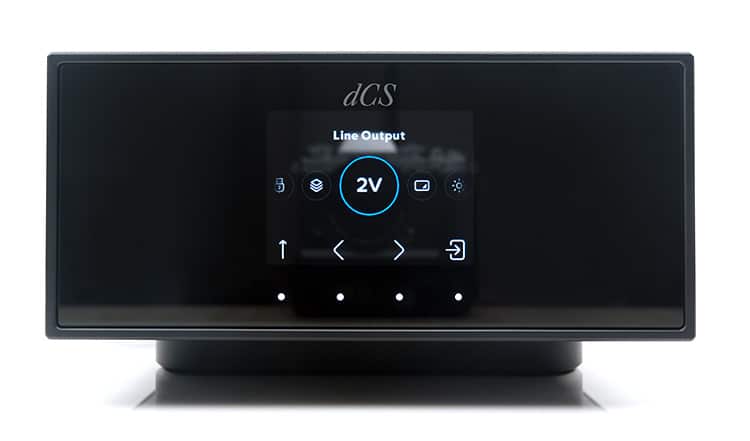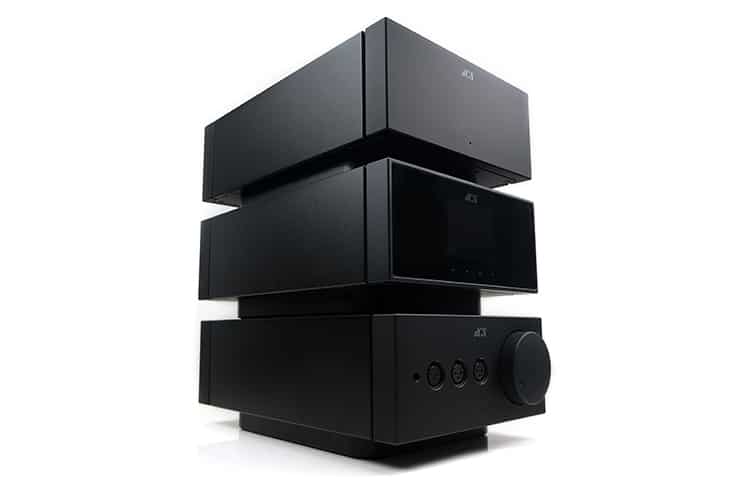Sound Impressions
All impressions below were completed using the Lina Headphone amplifier combined with the Abyss Diana TC, Audeze’s LCD-5, and the HIFIMAN Susvara. For some specific aspects, the Lina Master Clock was also included.
Summary
The Lina Network DAC is a high-energy, articulate performer with world-class levels of resolution and excellent dynamic range to go along with it.
It brings in very little in the way of coloration but if I had to make a snap judgment I would say it’s generally neutral to natural sounding and not as warm or as dense as Bartok’s equivalent DAC tuning.
Where I find it more immediate is the level of drive or ‘PRAT’ it injects into paired amplifier performances with demanding headphones such as the Diana TC. The punch and dynamic snap from the Lina Network DAC are both vivid and incisive. Nothing mushy or bloated at all to any amp pairing I tried it with.
The Lina Network DAC is the perfect partner to the Class AB Lina headphone amplifier allowing that excellent and strong dynamic low-end to come out so clearly whilst at the same time keeping the layering and decay under tight control.
Even more so with the Master Clock integrated and turned on which stretches the staging even deeper and taller whilst at the same time adding a whole new dimension of holographic complexity to instrumental and vocal imaging.
With its massive 6V output capability it has the guts to drive matching amplifiers and demanding planar headphones with aplomb. At the same time, dropping the voltage to incredibly low 0.2V and 0.6V ranges will bring in very low noise floors for quality amps to work just fine with more sensitive headphones and IEMs.
I actually found the Lina Network DAC 2V output setting to be the most refined and even-handed setting if you are a vocal lover or enjoy more intimate and delicate recordings with headphones. The harmonic balance is a little more accurate than the 6V equivalent.
Timbre
I honestly cannot find any fault with the timbral balance of the Lina Network DAC. Any overt coloration bias you are going to hear is going to come from your amplifier and of course the headphone of choice.
Of course, this is going to come down to personal preferences but for me, the harmonic balance is almost perfect for my tastes with a neutral to slightly natural tone to both instrumental and vocal timbre.
Where you might find bias is just how strong the fundamental becomes when combined with the Master Clock which seems to amplify the sub-bass presence and veracity of the mid-bass punch a bit more than the DAC alone.
The other slight variation in the timbral quality is the switch from 2V to 6V output where aspects of percussion timbre take on a slightly stronger upper harmonic presence inviting higher levels of detectable contrast into the texture.
I call this a more excitable tone and it does present itself as sounding quite bombastic whereas the more sedate 2V sounds calmer, more refined, and treats delicate vocal passages with more deference.
One other clear aspect of timbral variation is the use of the Crossfeed filter, particularly with clean-sounding and expansive headphones such as the HD800. Without the HD800 is feisty and clean sounding with more upper-mids and lower treble presence and a bit of sparkle on top.
With the Crossfeed applied the resulting tone is more liquid-like in its delivery, calmer, and slightly warmer sounding. It is less aggressive in its delivery with the imaging out in front rather than far left and right or ‘down each ear’ which can fatigue when paired with a bright-sounding amplifier.
Staging
The Lina Network DAC pushes out the presentation in all directions creating a very wide and deep quality with vocals slightly to the fore but also with a very nuanced softening of the treble presence.
This keeps the headroom very tall but without pushing the sparkle too hard and upsetting the general harmonic balance which can often pull your ear to one aspect of a performance over another.
Note decay does seem to be slightly short, well at least with the Lina Headphone amplifier but this seems to be a bonus in allowing detail to come through quickly without any dreaded smear. It does help a lot with micro-detail retrieval that the background is incredibly black allowing very slight far flung spatial cues to image beautifully.
Combined with the Lina Headphone amplifier and a headphone able to keep up with this pairing, the dynamic range is just spectacular. And it is not just the drama of a loud note hitting your ears in a lighting-like fashion but also the quieter moments that be quite breathtaking with the Lina Network DAC.
Delicate Dynamics
For example, Knut Reiersrud & Iver Kleive’s Min død er meg til gode from the 30 Years’ Fidelity compilation has this very soft and delicate opening sequence but is delivered within a very large hall-like acoustical environment.
It keeps a slow but steady 81 BPM rhythm with plenty of space to allow the mix of background harpsichord and guitar plucking to sound wonderfully defined and articulate. The imaging during this sequence with the Lina Network DAC combined with the Lina amplifier and the Diana TC is both immersive but delicately delivered at the same time.
Then, 3 minutes into a very soothing track those church organic kick in demonstrating the dynamic range of the setup wonderfully. You get a tremendous sense of space, not just out wide but three-dimensional space in terms of height and depth also. The stage sounds huge but at the same time quite connected and life-like.
Streaming Performance
Services
There are a number of methods to establish a connection for streaming services with the Lina Network DAC.
All of them start with an Ethernet or RJ45-based connection so, technically you could argue it is wired based though if you have something like a portable travel router you can also convert the Lina to receive a WiFi signal for lossless audio transmission.
If your plan is to use the Lina Network DAC for video-based media you do need to switch the buffer option off in the main unit settings menu or else you will get a bit of lag for audio sync. The buffer control is primarily for audio or music to reduce any audible clicks when there is a change in the bitrate.
Whilst you can establish a direct UPnP connection with the Lina Network DAC using the RJ45 input you can expand the level of streaming integration via the Mosaic App which is available for both Android and iOS users.
External Streaming
The Mosaic app integrated streaming services have not really changed that much since we reviewed the Bartok in 2020. You still get TIDAL, Qobuz, Spotify, and Deezer but new key players such as Amazon Music HD or Apple Music are still missing.
The excellent Podcast and Internet Radio services are still there and whilst the audio stream quality will drop to lossy via the Lina Network DAC the range of available channels and topics is excellent.
TIDAL, Qobuz, and Spotify users are directly integrated into Mosaic meaning you only need to enter your username and password to gain direct access to their respective libraries.
The Lina Network DAC will also display all the relevant streaming information from each service including streaming source, (TIDAL, Qobuz, etc.,), format, (e.g., MQA), bitrate, artist, and title. Given its larger screen size compared to the Bartok it also makes a bitter fist of organizing that information in a very legible manner.
Spotify
The level of integration and complexity of each service inside dCS Mosaic does differ though with Spotify a little on the clunky side compared to 3rd Party apps which have a more seamless level of integration.
You can resume Spotify playback inside the Mosaic framework but for browsing and selecting it pushes you to open up the Spotify app before allowing you to dive back into Mosaic once playback resumes.
TIDAL
TIDAL on the Lina Network DAC is superior via Mosaic, both in terms of audio quality with full MQA compatibility as well as in-app integration including volume control. You do get a fair boost in dynamic range performance making Spotify Premium playback sound compressed and boring on the Bartok.
It is not a complete home win. You do not get the full TIDAL app experience and it is much more list-based for navigation but it does highlight the key areas such as Masters and Rising which makes finding the quality MQA files a lot easier.
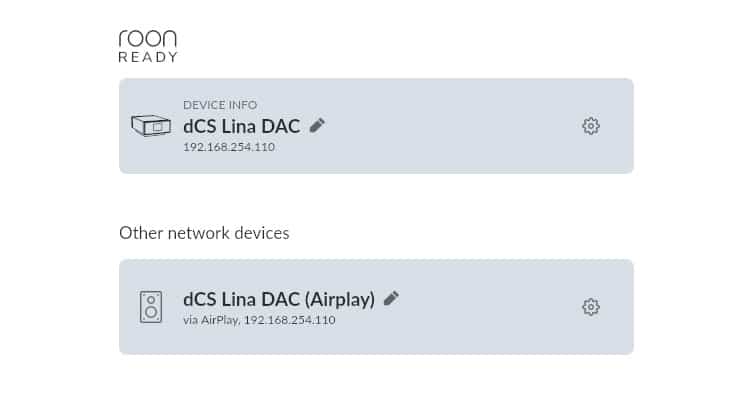
UPnP/DLNA
Once connected your DLNA or network-based UPnP services come alive offering a very hassle-free integration with the Lina Network DAC using Roon, (RoonReady), and Foobar2000, (UPnP option).
There is no requirement for an external internet-based connection for this to work either so, effectively you can create a dedicated or secure network for local media separate from your more security-sensitive internet connection.
However, if you want the complete experience including TIDAL and Qobuz integration with Roon or any 3rd Party service such as BubbleUPnP you will need an outward-looking Network service with net connectivity.
How effective the service is will depend entirely on the quality of your modem. For our modem here which is a bit of an old one, I had no issues streaming up to 24BIT/96k via TIDAL and up to 192K and DSD64 with Roon using our local media library.
Beyond that, using DSD128 our modem stutters with congestion since it is a shared modem service among a number of users. That’s not the fault of the Lina Network DAC but rather a limitation on our own network service capability.
Synergy
Master Clock Upgrade
Granted the Lina Master Clock is optional and will add to your overall costs when investing in the Lina system but I find it indispensable once you hook it up to the Lina Network DAC and hear the difference it makes.
I should also add it is not just applicable to the Lina system. If you have a Bartok also you can hook it up to the Master Clock and get some interesting results. We will also be pushing out a dedicated review of the Master Clock in the coming weeks that go into further detail about how it performs.
How best to describe the Master Clock effect on the Lina Network DAC performance? Dynamics is probably the first thing I would refer to. Everything sounds punchier, more incisive like shining a light or a magnifying glass on both the detail and pace at which that detail appears and disappears.
It’s kind of like the difference between the bounce of a taut and fresh tennis ball compared to a slightly deflated or overly used version of the same ball. The bounce is softer, and flatter with the old ball coming back to you at a much slower pace.
For example, using the Lina network DAC alone with the Lina Amplifier paired to the HD800 you get a comparatively flatter performance. Whereas moving to the Master Clock enhanced the bass dynamics, introduces better clarity in vocal layering mixes, and transforms the soundstage into a much more complex and deeper sounding experience.
Crossfeed
dCS has been beavering away with their crossfeed profiles since we originally reviewed the Bartok a few years ago.
Now, I am not normally a huge crossfeed guy but there are some instances when I do enjoy it, especially if the level of left/right channel separation is quite strong such as what the Sennheiser HD800 can often deliver.
With the Lina Network DAC crossfeed turned off the HD800 will give you it’s very typical expansive and very wide sound stage and at times you will pick up on the split with vocals often sounding layered or two vocals blasting at you at the same time from the extreme left and right.
For me, the HD800 just about mixes them to produce a single believable stereo field but if you are coming from more head gain forward headphones it will take some getting used to.
Enter the Lina Network DAC Expanse crossfeed options of which there are 3 and one in particular which works beautifully with the HD800 called option ‘c’. This filter pulls back the stage from a pure left/right experience to projecting the sound field more in front of you like a classic 2.1 setup.
In return, the HD800 sounds much more natural to my ear in terms of imaging coherence. It will not necessarily change the coloration of the HD800 but the imaging changes do have an effect of producing a smoother more agreeable sound and a slightly forward vocal to my ear. It also sounds a little less aggressive and more realistic in its presentation.
Voltage Preferences
The Lina Network DAC offers 4 different voltage levels ranging from a very gentle 0.2 and 0.6V output, (IEMs), to your standard 2V as well as a very dynamic 6V output.
The 2V will serve you well with the majority of amplifiers if you want to retain the highest level of purity from the resulting analog output. It works best with intimate recordings where you do not need huge dynamic ranges or a lot of punch and power in the performance.
I find the 2V a little smoother also for vocal and higher pitching percussion performances, especially with mid-forward headphones such as the LCD-5, though even the Susvara benefitted from this setting with vocals sounding a little less strained in their delivery.
The most powerful 6V setting though is very addictive in the way it ups the tempo and drive of any amplifier and headphone performance. It’s a solid choice for modern rock and pop with headphones that can dig deep when required. It also seems to particularly suit the already punchy Class AB character of the Lina headphone amplifier.
It also does a stellar job with dynamic responsive bass tunings from the likes of the Abyss Diana TC and the DCA Stealth. Both of these headphones have low-end presentations that can be fussy with their supporting setups and might not necessarily ‘come out to play’ with more reserved amplifiers.
Both headphones sounded quite muscular and filled in with the 6V setting from the Lina Network DAC powering the Lina headphone amplifier whereas the 2V shrank the stage a bit and pushed the performance a few rows back losing a bit of PRaT in the process.
Amplifier Setup
Without dipping into a straight amplifier shootout and since we have covered the Lina Headphone amplifier in some detail already I wanted to use this section to get a feel about how suited the stock sound of the Lina Network DAC was to two specific high-end amplifiers, the Feliks Audio Envy and the Cayin HA-300MK2.
This is in specific reference to headphone pairings and how each amplifier responded to both the crossfeed and the voltage output of the Lina Network DAC and which settings seem to work best with select headphones.
Core Tonal Qualities
What I can say is that the core attributes of the Lina Network DAC remain fairly true to each amplifier with a very detailed punchy and clear performance and an excellent, albeit robust, vocal body with an energetic delivery depending on which output voltage setting you use it with.
More so with the Envy which seems particularly suited to the Lina Network DAC sound signature traits being already a punchy and weighted SS rectifier tube design with a strong vocal focus. Having said that, the HA-300MK2 sounded particularly lively and detailed with the Lina Network DAC pairing.
The Cayin’s low-end performance does get a bit of a lift over more neutral DAC pairings such as the Hugo TT2 and the Aquarius and at the same time, the excellent holographic staging performance of the HA-300MK2 remains intact if not even more rapier-like in its delivery.
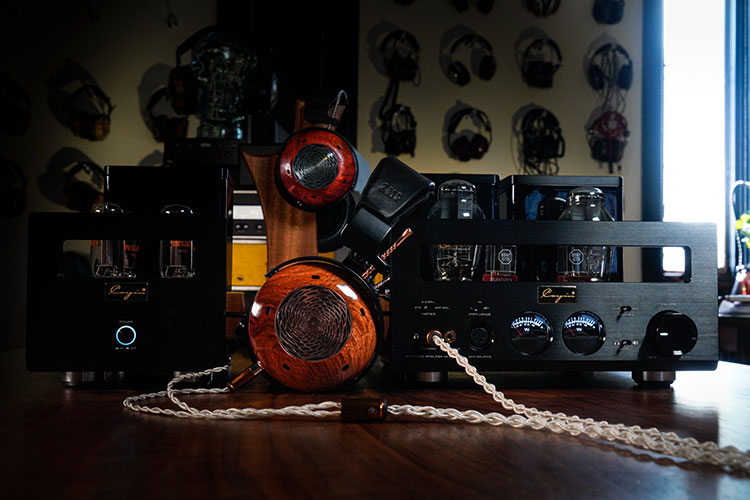
Cayin HA-300MK2 Tweaks
What headphones you are using with each amplifier does require a small measure of tweaks both at the amp side as well as on the Lina Network DAC side to get the right tonal quality just right.
For example, with the Cayin HA-300MK2 ZMF Headphone Atrium pairing the impedance level needs to be set to high on the amplifier side while keeping the voltage output of the DAC set at 2V.
I found the 6V setting much too aggressive when adjusting the gain of the Cayin amplifier unless I dropped the impedance setting down to low which isn’t ideal for a 300Ω-rated headphone. This combination kept the Atrium very smooth sounding with plenty of useable volume control.
With the Sennheiser HD800, I would also suggest the same settings but throw in the Crossfeed option C at the same time. The Cayin casts a very wide and holographic soundstage with most headphones, at least when compared to the Envy it does.
Turning on the Lina Network DAC Crossfeed will give the HD800 a much more natural soundstage quality and combined Cayin a very calming tonal quality at the same time.
Paired with more current intensive planar headphones such as the Final D8000 Pro I felt the 6V Lina Network DAC output setting combined with the low impedance setting of the Cayin amplifier to produce the smoothest timbral coloration and the punchier low-end response.
Feliks Audio Envy Tweaks
With the Envy, using the likes of the Abyss TC and the Susvara I had no issues opting for the 6V output from the Lina Network DAC and still got a very useable level of volume control with the amp’s high output power setting.
The Envy is the perfect partner for those who want more of a sense of urgency and rhythm from their tube amps without sacrificing any detail. It is a bit narrower than the Cayin amp and not as holographic but compensates with excellent depth.
I felt the Lina Network DAC warmed up to that task and in no way robbed the Envy of that signature tuning with two headphones that need plenty of current and voltage to sound just right.

